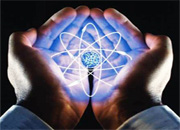This technology is poised to provide solutions to some of the most pressing challenges in health care, industry and security. Ion beams find application in developing the innovative materials needed for new quantum technologies. “The IAEA is fully engaged with worldwide initiatives in quantum technology,” said Aliz Simon, a nuclear physicist at the IAEA. “Ion beam accelerator techniques offer emerging opportunities to further explore and develop research in quantum technology.”
Since 2017, the IAEA has united experts from around the world through a coordinated research project (CRP) to develop materials for quantum technologies. The CRP includes the development of new experimental techniques and the refinement of theoretical models, with an aim to understand radiation effects and ion interaction processes.
“Taking advantage of quantum technology, we can manipulate the structure of materials at the atomic level with ion beams from accelerators, resulting in new types of materials used for quantum computing, sensing, cryptography, imaging and more,” said Simon, who leads the project. Ion beams are created when charged particles are accelerated.
The CRP has connected experts from Australia, China, Croatia, Finland, India, Israel, Italy, Japan, Singapore, Spain and the USA. “I was attracted to the CRP because of the promise to connect with people who I don’t normally talk to from different countries and from different disciplines. By bringing different representatives together and focusing efforts, we have been able to come up with new ideas that we wouldn’t have come up with separately,” said Thomas Schenkel, Head for Fusion Science and Ion Beam Technology at the Lawrence Berkeley National Laboratory in the USA.
For example, the CRP supported researchers who discovered how to use ion beams to create chains of closely coupled quantum bits (qubits). Qubits are basic units of information that are more complex and powerful than the information-carrying “bits” used in conventional computing. While prototypes of 10- to 50-qubit computers are being used to develop quantum software, the latest discovery shows potential to form quantum systems with up to 10,000 coupled qubits over the length of 50 microns, approximately the width of a strand of human hair. “We want to play with this more, explore the effect and then integrate qubit chains with control and readout electronics for quantum sensing applications, such as to probe the activity of neurons in the brain or to detect rare dark matter interaction events,” Schenkel said. Quantum sensors with qubits formed using ions beams are being developed in labs participating in the CRP. These sensors can provide highly accurate measurements and will improve the performance of everyday devices and services, from medical diagnostics and imaging to high-precision navigation.
The results of the study were published in the journal Applied Physics Letters in February this year. To date, CRP participants have published 55 scientific papers or book chapters related to new materials, modelling and new accelerator technology.
.jpeg)
Empowering the future of quantum
In this era of progress and growing interest, the CRP aims to improve understanding of and engage newcomers to the quantum field. In May, the IAEA hosted a four-day training workshop, Ion Beam Driven Materials Engineering: New Roles for Accelerators for Quantum Technologies. “I had limited knowledge of ion beams, and I wanted to gain a global and systematic perspective of it,” said Zikun Guo, a physics PhD student at the National University of Singapore. “I had not considered how high-energy could be applicable to ion beam research. This kind of training and discussion was quite useful, not only to bring everyone together, but also to bring different ideas.” The virtual training workshop gathered more than 80 participants, half of them from developing countries.
“The idea was not just to train and give knowledge, but also to equip people to enter the field and assess what they need in terms of infrastructure and knowledge from a collaborator’s point of view,” Simon said. “We want to expand accelerator labs dealing with quantum science, and we want to be practical to engage newcomers.”
There are 322 ion beam accelerators in the world listed in the IAEA Accelerator Knowledge Portal, “so there is great potential to foster the utilization of ion beam accelerators for quantum technology,” she added.
Joanne Liou, IAEA Office of Public Information and Communication


